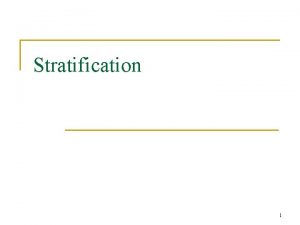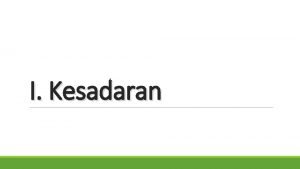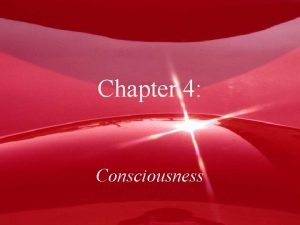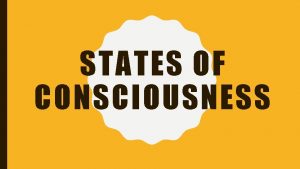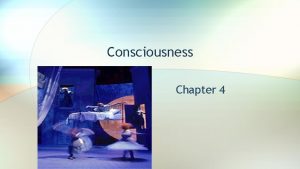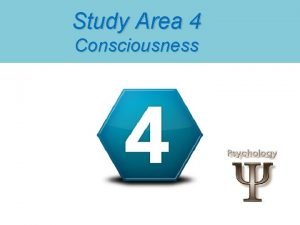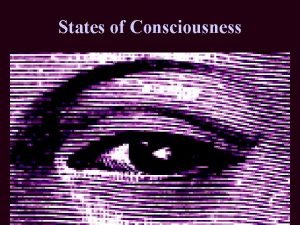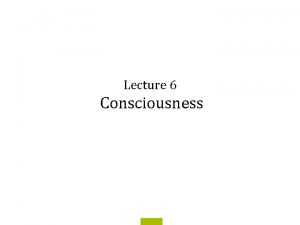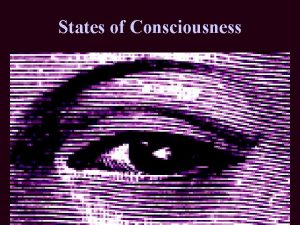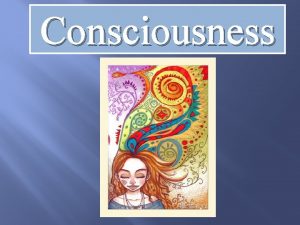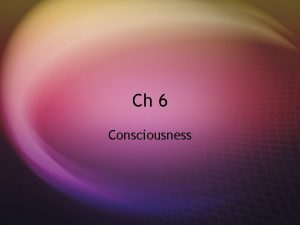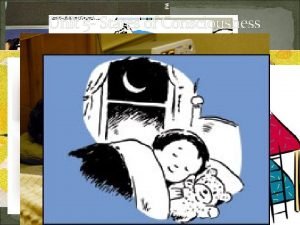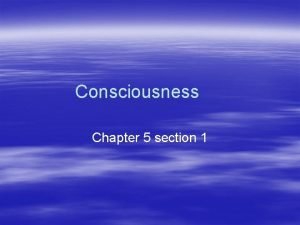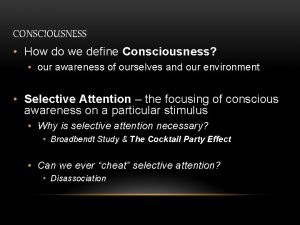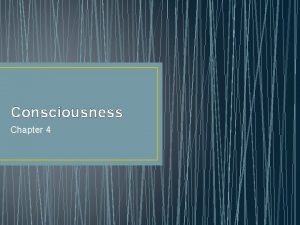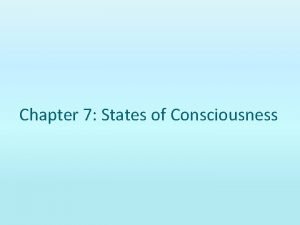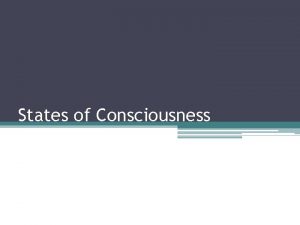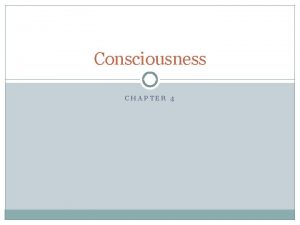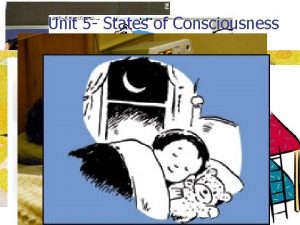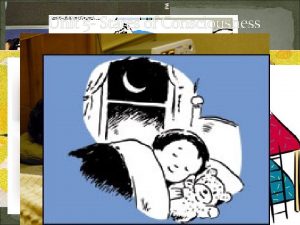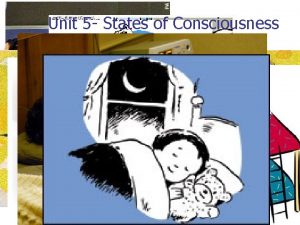The Nature of Consciousness Consciousness An active awareness
























- Slides: 24

The Nature of Consciousness • Consciousness: • “An active awareness of all the many thoughts, images, perceptions and emotions that occupy the mind at any given time“ - allows us to monitor ourselves, and our environment. - Gives us a sense of continuity, a way of linking experience, into a past, present & future. 1

• Without consciousness; (no sense of being, no sense of self ). • Cyclical state of consciousness: * Consciousness also changes according to a daily pattern called (sleep – wake - cycle). * Under normal conditions, we automatically reset our biological sleep clock in the twenty four hour light dark cycle. • When you across different time zones , it may take accommodation for sleep pattern 2

• people who works in rapidly rotating shifts as hospital nurses, often complain of sleep problems. • Sleep: - Increased amounts of certain neurotransmitters (serotonin) can promote sleep. - Brain also contains wake center and sleep centers. - Activation of sleep centers inhibit the wake center which causes sleep to take over. 3

Brain activity from wakefulness to deep sleep: • Psychologists have distinguished several stages of sleep by monitoring brain electrical activity, Electroencephalogram (EEG). Stages of sleep changes recorded by EEG: • Stage 1 (Awake): Person alert with eyes fully open. • Stage 2 (Close eyes to relax): brain wave become slower. 4

• Stage 3 (Fall a sleep): Sleep become progressively deeper. • Stage 4 (Deep sleep): the deepest stage of sleep, there is marked relaxation of muscles slow and regular breathing significant drop in body temperature & pulse rate, it occupies more than 50% of the sleep cycle. 5

• Stage 5 ( Rapid Eye Movement (REM) sleep): You remain a sleep, although your eyes move rapidly under your closed eyelids, This stage recurs on average 4 -5 times /night. • - REM sleep is closely associated with dreaming, and helps release energy associated with unsatisfied needs. 6

• - The cyclical state of sleep itself has a cycle that recurs about every 90 minutes. First, you fall into deeper and deeper sleep, then gradually return to stage (1), but you don’t actually wake up. 7

*The dreams of sleep: - Usually dreams are quickly forgotten because they are never consolidated in long term memory. • What determines dream content? • Freud believed that dreams reflect the repressed unconscious needs and unresolved conflicts of childhood. 8

Freud distinguish two types of dream content: a) Manifest content: Is the readily perceived story of the dream. b) Latent content: Is the deeper and the underlying meaning of the dream, it expresses unconscious wishes. * Alfred Adler, argued that dreams don't reflect unconscious wishes, he saw dreams as a continuation of whatever thought and feelings during waking hours. 9

Can we control dreams? • Some psychologists feel that controlling the content of emotionally negative dreams which frighten or disturb us is the best form of psychotherapy. 10

• Sleep Disorders: 1. Insomnia: Difficulty in falling asleep or staying asleep all the night. • -About 20% of people have insomnia during their life • - Brief episodes of insomnia caused by transient worries and stress. - chronic insomnia may be associated with mood disorder (mania or depression). 11

• Insomnia is treated by hypnotic medication, relaxation training, and stimulus control technique 2. Hypersomnia: Excessive sleepiness it may be associated with depression 3. Sleep Apnea: Stop breathing shortly after falling in sleep & then quickly wake up, gasping for air, And then sleep again. - This cycle is repeated, in severe cases it may occur 500 times / nigh. by the morning they feel exhausted from short sleeping. 12

• -Sleep apnea is caused by an over relaxation of throat muscles during sleeping, which leads to close airway. • Or it is caused by central nervous system disorder in which diaphragm and breath muscles stop working during sleep. 4. Narcolepsy: Excessive day time sleepiness or uncontrolled onset of sleep. " 13

• Daydreaming: • A train of thoughts that coming from the person's immediate situation in consciousness state. • Daydreams may be a way of helping to cope daily life problems e. g. students often daydream their study work, and future careers. 14

Induced States of Consciousness: *Drug – induced states: • Drug: is any substance that can alter the functioning of biological system. • Psychoactive drugs: - Those drugs that interact with CNS to alter a person’s mood, perception, mode of thinking or behavior. • A- Depressants : • Slow down the activities of CNS to reduce pain and anxiety, to relax. 15

*Alcohol (Depressant): • Alcohol to levels less than (0. 3%) in blood stream, perception becomes distorted, speech slurred , and trouble controlling his movements. - alcohol blood levels reach (0. 3 – 0. 4%) coma results. - If alcohol blood levels about 5% heart beat and breathing stop, and death occurs. 16

• Effects of Alcohol: -Alcohol causes memory impairment - Brain damage to about 10% of drinkers - Liver cirrhosis – - Social and behavioral problems 17

• Stimulants : • Produce psychological and mental arousal? • Decrease fatigue, increase talkativeness. • Increase physical activity-decrease appetite • produce a state of alertness- euphoria. 1 - Cocaine ( stimulant): - Prepared in the form of white powder inhaled or, sniffed into the nostrils, & It can be ingested also, or injected. 18

*Effects of Cocaine: - Euphoria. - Elevated mood, inflated sense of own abilities. - Increase physical activity and energy followed by a feeling of exhaustion after drug effect finished. - Chronic use: cause general mental deterioration and hallucination. 19

2 - Amphetamines (stimulant): • Students take it to stay awake, and women to decrease appetite and help burn off fat. • Effects: • -Produce energy – arousal and alertness as well as confidence. • -Users feel they can solve problems or achieve any goal. • Studies showed that amphetamine doesn’t improve problem-solving abilities. 20

• Chronic, excessive use: develop suspiciousness, depression & suicidal attempts. • Abuse can cause serious brain damage. ** Hallucinogens: • Drugs are capable to produce hallucinations 1. LSD (lysergic Acid Diethylamide): • * Effects: • Visual hallucinations- thought impairment, euphoria. 21

• 2 - Marijuana: • Minor hallucinogen usually smoked or eaten in food. • * Effects: • People take marijuana report that: colors are brighter, smells are richer, food tastes better. • - Chronic use: inability to concentrate on tasks for long. 22

** Meditations: • “An ancient technique for inducing a special state of consciousness without the use of drugs (e. g. -a yogi). • It involves focusing attention on a single stimulus. • used in the treatment of anxiety, insomnia, alcoholism, stuttering, & stress related problems. 23

**Hypnosis : • produce a state of relaxation and dissociation. (treatment of fearing & phobias). • Uses of hypnosis: • 1 - Alleviating pain • 2 - Treating certain behavioral problems as smoking, insomnia, and compulsive eating. 3 - Some believes that hypnosis can enhance memory. 24
 Horizontal mobility
Horizontal mobility Consciousness adalah
Consciousness adalah Consciousness includes awareness of
Consciousness includes awareness of Privacy awareness and hipaa privacy training cvs
Privacy awareness and hipaa privacy training cvs Membrane structures that function in active transport
Membrane structures that function in active transport Primary active transport vs secondary active transport
Primary active transport vs secondary active transport Active high and active low
Active high and active low Determinace lidské psychiky
Determinace lidské psychiky Nature and nature's law lay hid in night
Nature and nature's law lay hid in night Nguyên nhân của sự mỏi cơ sinh 8
Nguyên nhân của sự mỏi cơ sinh 8 Một số thể thơ truyền thống
Một số thể thơ truyền thống Trời xanh đây là của chúng ta thể thơ
Trời xanh đây là của chúng ta thể thơ So nguyen to
So nguyen to Tỉ lệ cơ thể trẻ em
Tỉ lệ cơ thể trẻ em Vẽ hình chiếu vuông góc của vật thể sau
Vẽ hình chiếu vuông góc của vật thể sau Các châu lục và đại dương trên thế giới
Các châu lục và đại dương trên thế giới Thế nào là hệ số cao nhất
Thế nào là hệ số cao nhất Sơ đồ cơ thể người
Sơ đồ cơ thể người Tư thế ngồi viết
Tư thế ngồi viết Hình ảnh bộ gõ cơ thể búng tay
Hình ảnh bộ gõ cơ thể búng tay đặc điểm cơ thể của người tối cổ
đặc điểm cơ thể của người tối cổ Cái miệng bé xinh thế chỉ nói điều hay thôi
Cái miệng bé xinh thế chỉ nói điều hay thôi Cách giải mật thư tọa độ
Cách giải mật thư tọa độ ưu thế lai là gì
ưu thế lai là gì Tư thế ngồi viết
Tư thế ngồi viết
